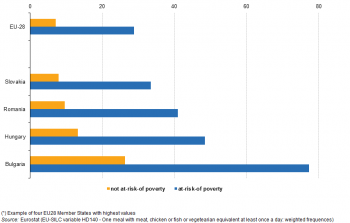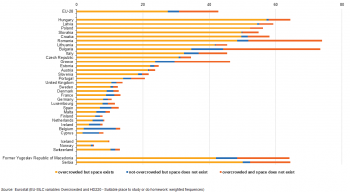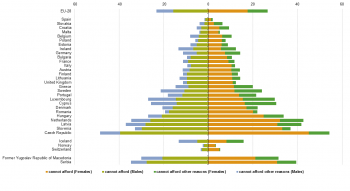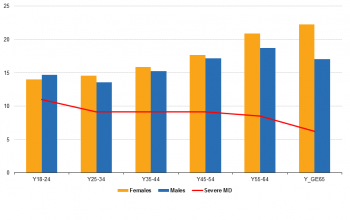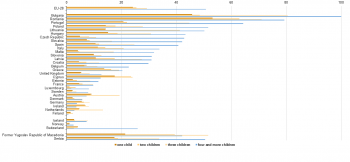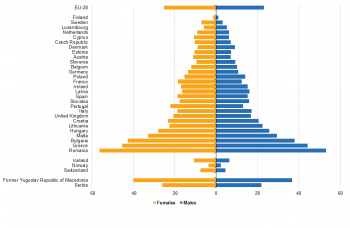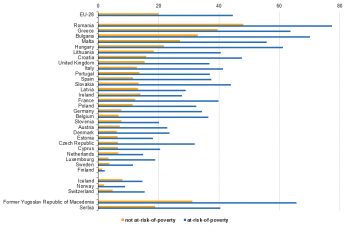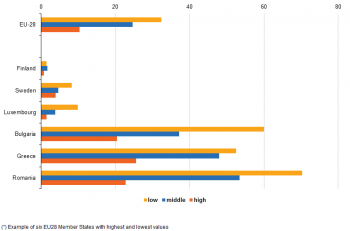Archive:Material deprivation statistics – financial stress and lack of durables
- Data extracted in July 2016.
This article is part of the Eurostat online publication Living conditions providing statistics on material deprivation in the European Union (EU) with focus on intra-household sharing of the resources for 2014. The publication presents a brief analysis of several different material deprivation variables (as part of the 2014 EU-SILC ad-hoc module) which relate to the household (as a whole), adults (people aged 16 and over) and children (all household members aged between 1 and 15). Observed variables, among others, are related to financial stress and durables, and leisure and social activities as a broader perspective of social inclusion measurements.
Even though it is tempting to assume that a change in a household’s income will affect all its members to the same extent, reality could differ dramatically. Using only household level indicators and attribute them equally to each member of the household, could possibly lead to unobserved child poverty and child deprivation as well as of the other age- and gender-groups within the same household. In order to shed some light on the intra-household transfers and within-household differences in living conditions, the EU-SILC included a special ad-hoc material deprivation module (first time for 2009, and revised for 2014) which allows to observe this separately for different demographics.
The variables related to children’s items are collected for the whole group of children with one very specific rule: If at least one child does not have the item in question, the whole group of children in the household is assumed to not have the item either. On the other hand, information on basic needs, as well as leisure and social activities for adults is provided for each household member aged 16 and over.
Analyses used for the article cover all EU Member States and several non-EU Member States.
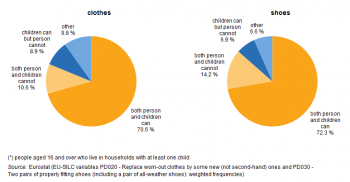
(% of adults)
Source: Eurostat (EU-SILC variables PD020 - Replace worn-out clothes by some new (not second-hand) ones and PD030 - Two pairs of properly fitting shoes (including a pair of all-weather shoes): weighted frequencies)
Main statistical findings
Child deprivation
In 2014, 27.4% of children aged below 16 in the EU-28 were at risk of poverty or social exclusion (AROPE ) compared with 25.5% of adults aged between 16 and 64, and 17.7% of the elderly (aged 65 or over).
The main EU-SILC indicators (Europe 2020 target on poverty and social exclusion) measure living conditions using general indicators of the household as a whole and they are based on the assumption that the recourses are equally distributed to all household members. The aim of this part is to show if the situation changes when we observe some of the material deprivation variables separately for specific child groups (children aged 1-15).
This part of the article focuses on several material deprivation items – meal and lack of space, and on the household’s (in)ability to afford them for all children and (or) for all its members.
As mentioned at the beginning, due to specific characteristics of the collected information (i.e. the number of variables and breakdown details) and missing values, some households (and their members) are excluded from the analysis.
Food-deprivation
In 2014, based on the EU-SILC survey, 13.2% of children were living in households which could not afford a meal for all children every day.
The context of food-deprivation in this article is focused on households which could not afford one meal with meat, chicken or fish (or vegetarian equivalent) for all children at least once a day. Figure 1.1 shows the proportions of children who lived in households which could not afford a meal for all children at least once a day by monetary poverty. As assumed, proportions of children who lived in households which were at risk of poverty were much higher when compared with the ones who are not (at EU28 level – 7.1% in households not at risk of poverty and 28.8% in households at risk of poverty).
The highest proportions of children, among EU-28, who lived in households which were at risk of poverty and which could not afford one meal per a day for all children, were recorded in Bulgaria (77.2%), Hungary (48.5%) and Romania (40.9%).
Among children who lived in households which are not at risk of poverty, more than 26% of them lived in Bulgaria in households which could not afford at least one meal per day for all children. In 2014, based on the EU-SILC survey, 14.9% of children in EU lived in households which could not afford a meal for all its members at least every second day. In comparison, 13.2% of children lived in households which could not afford a meal for all children every day.
Lack of space
In 2014, 40.7% of children in the EU lived in overcrowded households . Also, 14.1% of children lived in households which could not afford a suitable place for them to study or do homework.
In Romania and Hungary, over 80% (81.8% and 81.4% respectively) of children lived in overcrowded households which were also at risk of poverty. Moreover, in Romania, around 64.3% of children lived in overcrowded households which were not at risk of poverty. The lowest proportion of children (below 5%) who lived in overcrowded households was in Belgium (2.7%), Cyprus (2.9%), Ireland and Norway (4.1% both).
Among the EU-28, Bulgaria was the country with the highest percentage (64.0%) of children who lived in households at risk of poverty and did not have space to study due to financial reasons. On the contrary, Finland had the lowest share of children who lived in households with the aforementioned characteristics – only 3.4%.
Even though there is an evident difference in whether a household is at risk of poverty or not, for some countries, proportions of children who lived in households which were not at risk of poverty but who still could not afford a space for school-age children, were relatively high – Bulgaria (28.1%), Romania (18.0%) and Spain (17.4%). However, for majority of EU and non-EU Member States, this share of children was less than 4%. Since the shares of children who lived in overcrowded households for most EU-28 countries were relatively high (at EU28 level - 36.5% in households not at risk of poverty and 54.6% in households at risk of poverty), the aim of the next part of the article is to see if the lack of space for studying and doing homework for school-aged children is linked to a lack of space.
The majority of people lived in households which were not overcrowded and where the suitable space existed. However (see Figure 1.2), in Belgium and Bulgaria almost 10% of households were not overcrowded but still did not have space to study for children. Furthermore, in Hungary, Latvia and Poland, over 50% of people lived in overcrowded households but with enough space for school-aged children to study or do their homework (57.3%, 54.4% and 52.2% respectively).
Inter- and intra-generational differences
One of the main EU-SILC indicators – AROPE, showed that young persons (under 25) present the most vulnerable group. More precisely, the percentage of people who lived in severe material deprivation and in households at risk of poverty (AROPE) was slowly decreasing with age – from 31.9% for age group 18-24 to 17.8% for people aged 65 and over.
The aim of this part of the article is to apply a broader perspective of material deprivation, i.e. inability to afford a selection of items (goods or services) and if this pattern still exists if we observe them at personal level. To adequate measure children’s material deprivation it is necessary to look not only at the material deprivation that solely affects children but also at the material deprivation that affects the entire household as this is likely to impact their living conditions.
Data sources and availability
<description of data sources, survey and data availability (completeness, recency) and limitations>
Context
<context of data collection and statistical results: policy background, uses of data, …>
See also
- Name of related Statistics Explained article
- Name of related online publication in Statistics Explained (online publication)
- Name of related Statistics in focus article in Statistics Explained
- Subtitle of Statistics in focus article=PDF main title - Statistics in focus x/YYYY
Further Eurostat information
Data visualisation
- Regional Statistics Illustrated - select statistical domain 'xxx' (= Agriculture, Economy, Education, Health, Information society, Labour market, Population, Science and technology, Tourism or Transport) (top right)
Publications
Publications in Statistics Explained (either online publications or Statistics in focus) should be in 'See also' above
Main tables
- Title(s) of second level folder (if any)
- Title(s) of third level folder (if any)
Database
- Title(s) of second level folder (if any)
- Title(s) of third level folder (if any)
Dedicated section
Methodology / Metadata
<link to ESMS file, methodological publications, survey manuals, etc.>
- Crime and criminal justice (ESMS metadata file — crim_esms)
- Title of the publication
Source data for tables, figures and maps (MS Excel)
Other information
<Regulations and other legal texts, communications from the Commission, administrative notes, Policy documents, …>
- Regulation (EC) No 1737/2005 (generating url [http://eur-lex.europa.eu/LexUriServ/LexUriServ.do?uri=CELEX:32005R1737:EN:NOT Regulation (EC) No 1737/2005]) of DD Month YYYY on ...
- Directive 2003/86/EC (generating url [http://eur-lex.europa.eu/LexUriServ/LexUriServ.do?uri=CELEX:32003L0086:EN:NOT Directive 2003/86/EC]) of DD Month YYYY on ...
- Commission Decision 2003/86/EC (generating url [http://eur-lex.europa.eu/LexUriServ/LexUriServ.do?uri=CELEX:32003D0086:EN:NOT Commission Decision 2003/86/EC]) of DD Month YYYY on ...
<For other documents such as Commission Proposals or Reports, see EUR-Lex search by natural number>
<For linking to database table, otherwise remove: {{{title}}} ({{{code}}})>
External links
Notes
[[Category:<Subtheme category name(s)>|Name of the statistical article]] [[Category:<Statistical article>|Name of the statistical article]]
Delete [[Category:Model|]] below (and this line as well) before saving!
